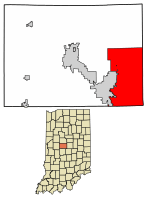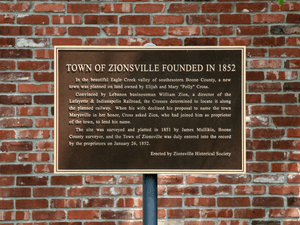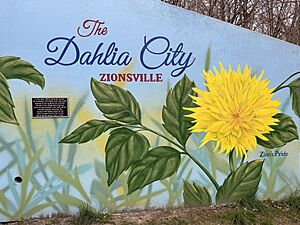Zionsville, Indiana facts for kids
Quick facts for kids
Zionsville, Indiana
|
|||
|---|---|---|---|

Looking north along Main Street, 2008
|
|||
|
|||

Location of Zionsville in Boone County, Indiana.
|
|||
| Country | United States | ||
| State | Indiana | ||
| County | Boone | ||
| Townships | Eagle, Union, Perry | ||
| Area | |||
| • Total | 67.34 sq mi (174.41 km2) | ||
| • Land | 67.22 sq mi (174.09 km2) | ||
| • Water | 0.12 sq mi (0.32 km2) | ||
| Elevation | 919 ft (280 m) | ||
| Population
(2020)
|
|||
| • Total | 30,603 | ||
| • Density | 455.29/sq mi (175.79/km2) | ||
| Time zone | UTC-5 (Eastern (EST)) | ||
| • Summer (DST) | UTC-4 (EDT) | ||
| ZIP code |
46077
|
||
| Area code(s) | 317 | ||
| FIPS code | 18-86372 | ||
| GNIS feature ID | 2397761 | ||
| Website | zionsville-in.gov | ||
Zionsville is a friendly town located in Boone County, Indiana, in the United States. It is northwest of Indianapolis. In 2020, about 30,693 people lived here.
Zionsville is known for its charming downtown area. This area looks like a small village. Its main street is paved with bricks. You can find many small shops and restaurants there. It's a popular spot for visitors!
Contents
History of Zionsville
Zionsville was founded in 1852. This happened when a railroad line was built through the area. The town was named after William Zion, who was an early settler.
An important moment in history happened here in 1861. Abraham Lincoln gave a short speech in Zionsville. He was on his way to become president. Later, in 1865, the train carrying Lincoln’s body passed through Zionsville. This was part of its long journey to his final resting place.
The old Town Hall, also called Castle Hall, is a historic building. It was added to the National Register of Historic Places in 1983. This means it's an important place to protect.
In the 1920s, Zionsville was known as "The Dahlia City." This was because two plant nurseries in the area grew beautiful dahlia flowers. Starting in 2019, the Zionsville Cultural District brought this nickname back. They gave away free dahlia flowers and painted a mural to celebrate.
Geography and Climate
Zionsville is about 15 miles (24 km) northwest of Downtown Indianapolis. In 2010, the town covered about 10.3 square miles (26.7 square kilometers). Most of this area is land.
In 2010, Zionsville grew much larger. It added about 39.5 square miles (102.3 square kilometers) of land. This made the town's total area about 49.7 square miles (128.7 square kilometers). In 2014, it grew even more, adding 3.9 square miles (10.1 square kilometers). Now, the town's area is about 53.63 square miles (138.9 square kilometers).
Zionsville's Climate
The weather in Zionsville has four clear seasons. Summers are hot and humid. Winters are cold. The town has enough rain and snow throughout the year. This type of weather is called a humid continental climate.
Population Changes
| Historical population | |||
|---|---|---|---|
| Census | Pop. | %± | |
| 1860 | 365 | — | |
| 1870 | 956 | 161.9% | |
| 1880 | 855 | −10.6% | |
| 1890 | 825 | −3.5% | |
| 1900 | 765 | −7.3% | |
| 1910 | 840 | 9.8% | |
| 1920 | 957 | 13.9% | |
| 1930 | 1,131 | 18.2% | |
| 1940 | 1,314 | 16.2% | |
| 1950 | 1,536 | 16.9% | |
| 1960 | 1,822 | 18.6% | |
| 1970 | 1,857 | 1.9% | |
| 1980 | 3,948 | 112.6% | |
| 1990 | 5,281 | 33.8% | |
| 2000 | 8,775 | 66.2% | |
| 2010 | 14,160 | 61.4% | |
| 2020 | 30,603 | 116.1% | |
| U.S. Decennial Census | |||
Population in 2020
In 2020, Zionsville had 30,693 people living there. There were 10,061 households. Most people (91.4%) were White. About 4.3% were Asian, and 1.4% were African American. People of Hispanic or Latino background made up 2.2% of the population.
The average age in Zionsville was 39.1 years old. About 28% of residents were under 18. About 12.9% were 65 or older. The town had slightly more males (50.5%) than females (49.5%). The average income for a household was $137,265.
Population in 2010
In 2010, Zionsville had 14,160 people. There were 5,129 households. The racial makeup was mostly White (94%). About 2.7% were Asian and 1.2% were African American. Hispanic or Latino people made up 2.1% of the population.
Many households (44.1%) had children under 18. The average age was 39.6 years. About 31.6% of residents were under 18.
Education in Zionsville
The Zionsville Community School Corporation is very well-regarded. It includes schools in Eagle and Union townships. For many years, it has been ranked among the top public school systems in Indiana.
Zionsville schools have friendly rivalries with schools in nearby towns. These include Carmel, Lebanon, and Pike Township in Indianapolis. Rebecca Coffman is the current superintendent of schools.
Schools in Zionsville
- Zionsville Community High School
- Zionsville Middle School
- Zionsville West Middle School
- Eagle Elementary School
- Pleasant View Elementary School
- Stonegate Elementary School
- Union Elementary School
- Boone Meadow Elementary School
- Trailside Elementary School
The town also has a public library. It is called the Hussey-Mayfield Memorial Public Library.
Cultural Attractions
Zionsville is home to the SullivanMunce Cultural Center. This center has a museum, an art center, and a place to research family history. It shows items from the town's past. The center also hosts many events throughout the year.
One popular event is the July Fourth fireworks show. The local Lion's Club hosts it every year. People from all over Indiana come to watch. There are concerts before the fireworks begin.
Another fun event is the Fall Festival. It happens for one weekend in September. The festival includes a parade with sports teams and marching bands. There are also rides, games, and food at the Lion's Park.
Zionsville also has the Goldman Union Camp Institute (GUCI). This is a Jewish camp that is part of the URJ (Union for Reform Judaism).
Transportation
Highways
Zionsville is connected by several major roads:
 Interstate 65
Interstate 65 Interstate 465
Interstate 465 Interstate 865
Interstate 865 US 52 (runs with I-65, I-465, and I-865)
US 52 (runs with I-65, I-465, and I-865) US 421
US 421 State Road 32
State Road 32 State Road 267
State Road 267
Airports
The Indianapolis Executive Airport (KTYQ) is located north of downtown Zionsville. It helps take some air traffic away from the larger Indianapolis International Airport.
Railroads and Trails
A railroad line used to run through Zionsville. It was built in 1852 but stopped being used in 1976. In the 1990s, Zionsville turned parts of this old railroad line into a shared use path. It is now called the Big-4 Rail Trail.
The Rail Trail connects different parks, neighborhoods, and interesting spots in town. These include Heritage Park, Jennings Field, and Starkey Park. It is also close to Mulberry Fields and the downtown village. Trees surround most of the trail, making it a nice place to walk or bike. The trail is currently being extended.
Notable People
Many interesting people have lived in or are connected to Zionsville:
- Albert B. Anderson, a federal judge
- Mark Baltz, an NFL official
- Jeff Belskus, a former CEO of Hulman & Company and president of Indianapolis Motor Speedway
- Brandon Bernstein, an American drag racer
- Antoine Bethea, a former safety for the Indianapolis Colts and Arizona Cardinals
- Gary Brackett, a former linebacker for the Indianapolis Colts
- Tom Carnegie, a famous announcer for the Indianapolis 500 race
- Dallas Clark, a former tight end for the Indianapolis Colts
- Austin Collie, a former wide receiver for the Indianapolis Colts
- Austin Croshere, a former NBA basketball player
- Dan Dakich, a former college basketball coach
- Ryan Diem, a former offensive tackle for the Indianapolis Colts
- Danny Granger, a former small forward for the Indiana Pacers and Miami Heat
- Stéphan Grégoire, a race car driver
- Arthur G. Hansen, a former president of Georgia Institute of Technology and Purdue University
- Grace Hartzel, a fashion model
- Bill Hodges, a college basketball coach
- John-Michael Liles, an NHL defenseman
- Tom Mastny, a former pitcher for the Cleveland Indians
- Derrick McKey, a former NBA player
- Rob Morris, a former linebacker for the Indianapolis Colts
- Nancy Noel, an artist
- Chuck Pagano, a former head coach for the Indianapolis Colts
- Metta World Peace, a former forward for the Indiana Pacers
- Kendall Phillips, a country music singer
- Jerraud Powers, a former defensive back for the Indianapolis Colts
- Jeff Saturday, a former center for the Indianapolis Colts and Green Bay Packers
- David Shumate, a poet
- Hunter Smith, a former punter for the Indianapolis Colts
- Rik Smits, a former center for the Indiana Pacers
- John Stehr, a former news anchor and current Mayor of Zionsville
- Lance Stephenson, a former NBA player
- Brad Stevens, president of basketball operations for the Boston Celtics
- Hardress Nathaniel Swaim, a federal judge
- Jacob Tamme, a former tight end for the Indianapolis Colts and Denver Broncos
- Jack Trudeau, a former NFL quarterback
- Kelly Williamson, a triathlete
- Todd Witsken, a professional tennis player
- Shannon Elkins, a teacher at Zionsville Middle School
See also
 In Spanish: Zionsville para niños
In Spanish: Zionsville para niños







